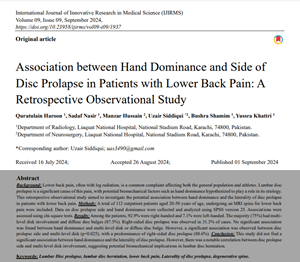Association between Hand Dominance and Side of Disc Prolapse in Patients with Lower Back Pain: A Retrospective Observational Study
Main Article Content
Abstract
Background: Lower back pain, often with leg radiation, is a common complaint affecting both the general population and athletes. Lumbar disc prolapse is a significant cause of this pain, with potential biomechanical factors such as hand dominance hypothesized to play a role in its etiology. This retrospective observational study aimed to investigate the potential association between hand dominance and the laterality of disc prolapse in patients with lower back pain. Methods: A total of 112 outpatient patients aged 20-50 years of age, undergoing an MRI spine for lower back pain were included. Data on disc prolapse side and hand dominance were collected and analyzed using SPSS version 25. Associations were assessed using chi-square tests. Results: Among the patients, 92.9% were right-handed and 7.1% were left-handed. The majority (75%) had multi-level disk involvement and diffuse disc bulges (87.5%). Right-sided disc prolapse was observed in 31.3% of cases. No significant association was found between hand dominance and multi-level disk or diffuse disc bulge. However, a significant association was observed between disc prolapse side and multi-level disk (p=0.025), with a predominance of right-sided disc prolapse (88.6%). Conclusion: This study did not find a significant association between hand dominance and the laterality of disc prolapse. However, there was a notable correlation between disc prolapse side and multi-level disk involvement, suggesting potential biomechanical implications in lumbar disc herniation.
Article Details

This work is licensed under a Creative Commons Attribution 4.0 International License.
